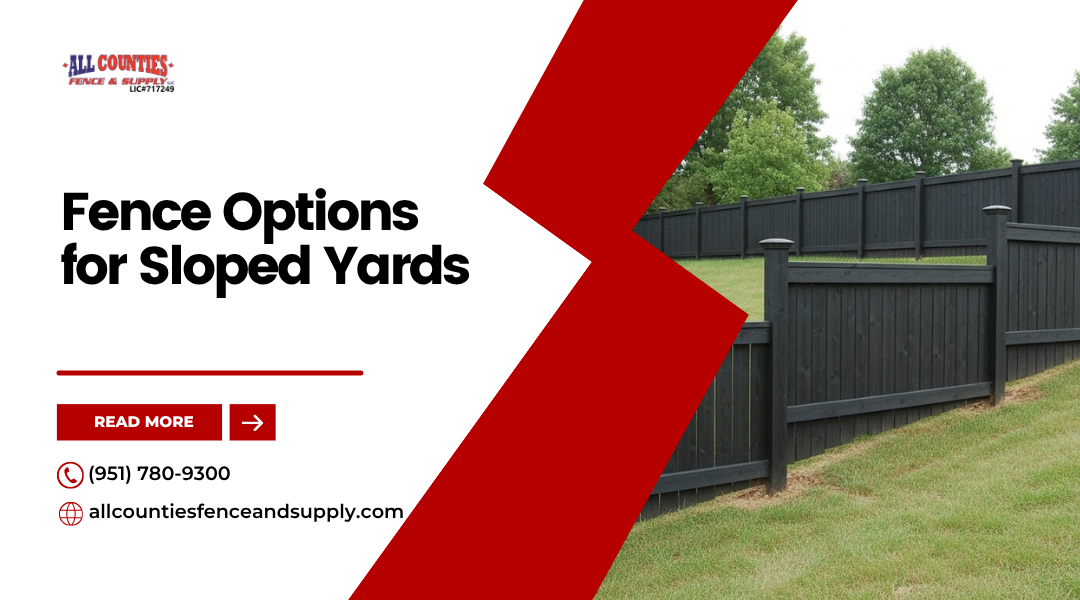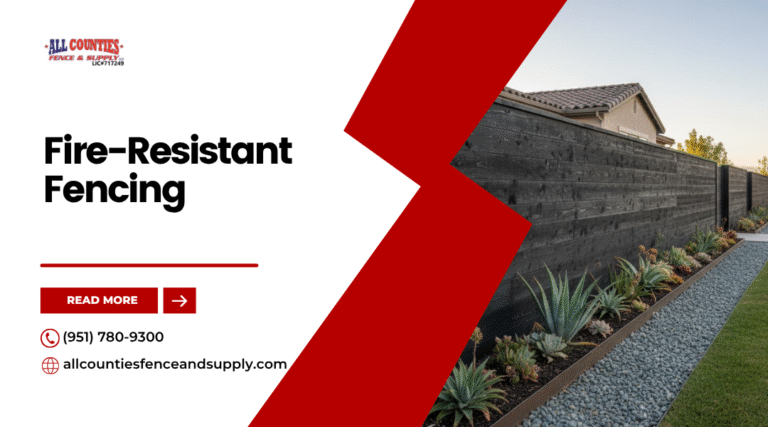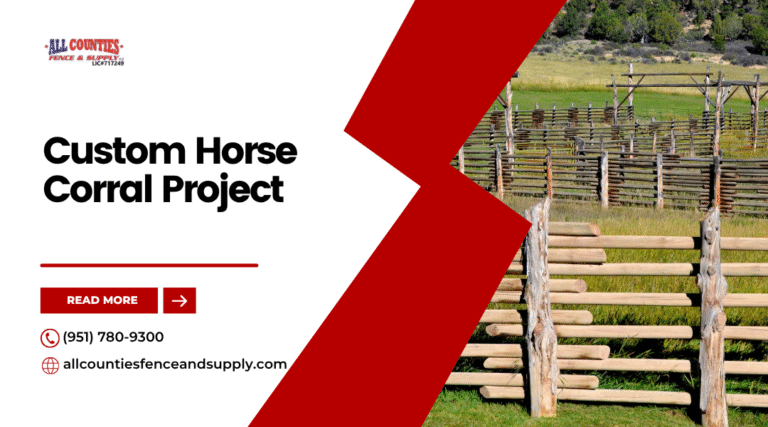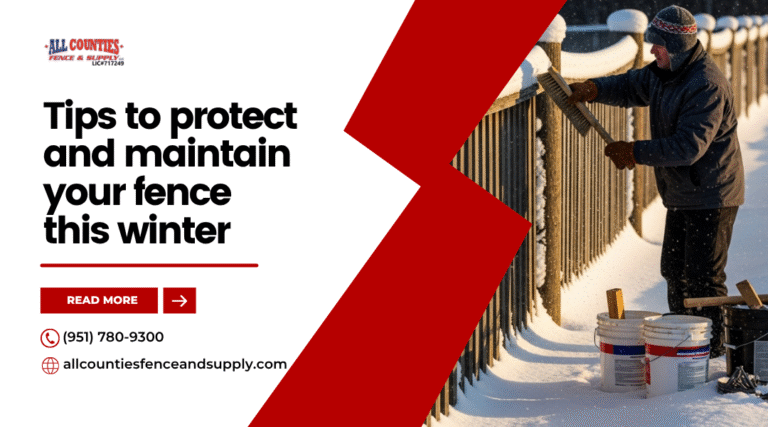Building a fence on a sloped yard in Riverside takes more than just choosing a style you like—it requires understanding how terrain, materials, and installation methods work together. Elevation changes can create gaps, uneven lines, or drainage issues if not handled correctly. The best fence options for sloped yards in Riverside combine durability, adaptability, and design flexibility to secure your property while maintaining a clean, cohesive look.
You’ll discover that certain materials—like rackable aluminum, stepped wood panels, or flexible chain-link—perform better on uneven ground. Each option offers unique advantages depending on your yard’s grade and your goals for privacy, security, or curb appeal. Knowing how to match the right installation method to your slope can save time, reduce maintenance, and improve long-term stability.
Local factors in Riverside, such as soil type, drainage patterns, and city height regulations, also influence which fence design works best. With expert insight from trusted professionals like All Counties Fence & Supply, you can create a fence that not only fits your property’s terrain but also enhances its overall value and appearance.
Why Sloped Yards Require Special Fencing Solutions
Installing a fence on a sloped yard in Riverside involves more than aligning posts and panels. The city’s varied terrain, soil composition, and seasonal water runoff patterns demand careful design choices to maintain both safety and appearance.
Common Grading Challenges in Riverside Properties
Many Riverside neighborhoods sit on rolling hills or foothill terrain where grade changes can vary several feet across a property line. These slopes often feature sandy or clay-heavy soils that shift during dry and wet seasons, affecting post stability.
You may also encounter uneven elevation transitions between neighboring lots. This creates alignment issues when trying to maintain consistent fence height or spacing.
Surveying your property’s slope gradient—measured as rise over run—helps determine whether you need stepped, rackable, or contour fencing. A slope greater than 15 degrees usually requires deeper post settings and reinforced footings.
| Slope Grade | Typical Adjustment Needed | Recommended Fence Type |
|---|---|---|
| 1–10° | Minor leveling | Rackable panels |
| 11–20° | Stepped installation | Stepped or contour |
| 21–30° | Deep posts + bracing | Retaining wall + fence |
Accurate grading measurements prevent misalignment and reduce long-term maintenance caused by soil movement.
Risks of Standard Fence Installation on Uneven Terrain
Using traditional flat-ground fencing on uneven or hilly yards often leads to structural and visual problems. Standard panels leave gaps at the base, allowing pets to escape and reducing privacy.
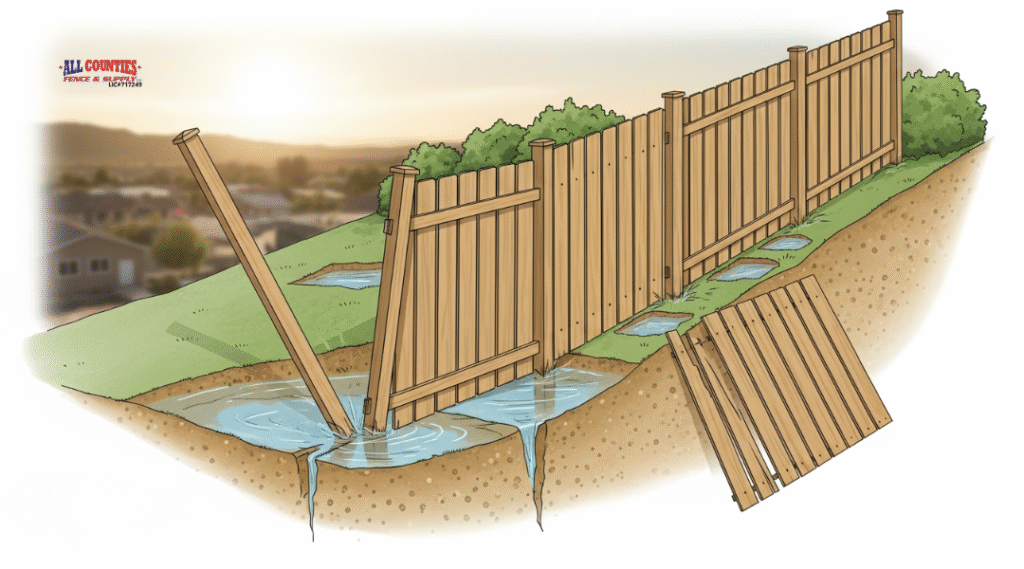
Posts installed at uniform heights on sloped ground can lean downhill over time due to lateral soil pressure. This movement weakens connections and causes panels to warp or separate.
You also risk water pooling against fence bases when posts are not properly leveled. Over time, this moisture accelerates rot in wood and corrosion in metal.
To avoid these issues, you should select fencing systems designed to follow the grade. Adjustable brackets, stepped panels, or flexible rackable rails maintain both alignment and durability on sloped terrain.
Importance of Drainage and Structural Stability
Riverside’s seasonal rains create significant water runoff on sloped yards, especially where clay soils limit absorption. Poor drainage can erode soil around post bases and compromise concrete footings.
Proper installation includes gravel backfill, weep holes, and drainage channels to redirect water flow. These features prevent hydrostatic pressure from pushing against posts or retaining walls.
You should also reinforce posts with deeper concrete footings—typically 6 inches deeper for every 15 degrees of slope. Using galvanized or stainless-steel hardware reduces corrosion from moisture exposure.
Attention to structural stability ensures your fence withstands both gravity and water movement. Combined with good drainage, these measures help your sloped yard fence remain secure and functional for years.
Main Installation Methods for Sloped Fencing
Installing a fence on a slope requires choosing the right method to maintain both stability and appearance. The main techniques differ in how they handle grade changes, post alignment, and panel spacing, which directly affect durability and visual consistency.
Stepped Fencing: Defined Levels for a Structured Look
A stepped fence uses level panels arranged in a stair-step pattern to adapt to uneven ground. Each section stays horizontal while posts are set at varying heights to match the slope. This method works best for moderate to steep grades where maintaining a uniform top line is important.
You install posts at consistent intervals, typically 6–8 feet apart, and adjust each panel’s height to align with the next. The result is a clean, geometric appearance that complements modern or formal landscapes.
Stepped fences are ideal for wood, vinyl, or metal panels that cannot flex easily. They prevent large gaps at the bottom, improving privacy and security. However, this approach can create small triangular spaces under panels on steeper slopes, which may require infill boards or landscaping to close.
| Slope Type | Recommended Post Depth | Typical Panel Width |
|---|---|---|
| Gentle (1–10°) | 24 in | 8 ft |
| Moderate (11–20°) | 30 in | 6 ft |
| Steep (21–30°) | 36 in | 4 ft |
Racked (Contoured) Fencing: Following the Slope Seamlessly
A racked fence, also called a contoured fence, follows the natural grade of the land without stepping. The rails and pickets adjust to the slope, creating a continuous line that mirrors the ground’s contour. This design eliminates gaps and maintains a smooth transition along the terrain.
Racked fences are best for gentle slopes up to about 25 degrees. The panels pivot slightly at the posts, forming a parallelogram shape that keeps the top and bottom rails parallel to the ground. Materials like aluminum, vinyl, and chain link are common because they flex easily without losing strength.
This method reduces soil erosion issues by staying close to the ground. It also minimizes the need for grading or retaining walls, making it efficient and visually cohesive for sloped yards that need a uniform look.
Hybrid Approach: Combining Both for Function and Aesthetics
A hybrid installation blends stepped and racked techniques to handle varied terrain. You use stepped sections on steep areas for structure and racked panels on gentler slopes for a smoother line. This approach allows flexibility across a property with mixed elevations.
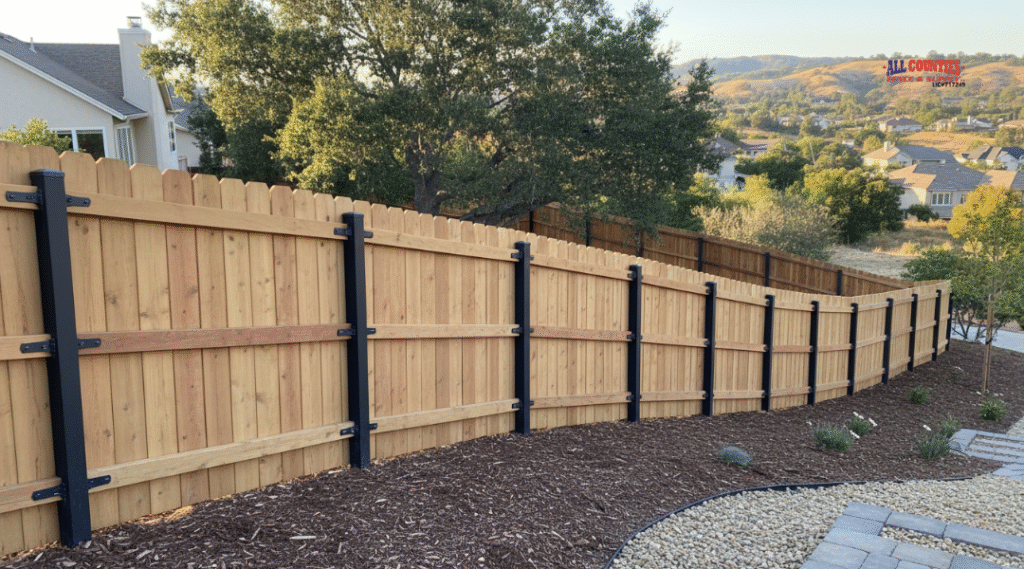
You can maintain consistent fence height where needed while allowing natural flow elsewhere. Hybrid fences often use modular systems with adjustable brackets and mixed materials to simplify transitions between levels.
This method suits properties where slope angles change frequently or where aesthetics and drainage both matter. It provides strong post anchoring on steep grades while keeping visual continuity across the yard. Proper planning and accurate grade measurement ensure each section aligns cleanly without gaps or uneven tension.
Best Fence Materials for Sloped Terrain
Selecting the right material for a sloped yard in Riverside depends on durability, flexibility, and maintenance needs. Materials such as vinyl, wood, metal, and chain-link each handle changes in elevation differently, offering distinct advantages for local weather and soil conditions.
Vinyl Fencing — Flexible and Low-Maintenance for Riverside’s Climate
A vinyl fence works well on sloped or uneven ground because of its flexibility and resistance to moisture. In Riverside’s dry summers and mild winters, vinyl panels resist cracking, fading, and warping better than untreated wood. You can install vinyl fencing using a racked or stepped method to follow the yard’s grade.
Vinyl requires little upkeep beyond occasional cleaning with soap and water. It does not need painting or sealing, which saves time and cost over the years. You can also find vinyl fence panels in various colors and textures that mimic wood without the risk of rot or insect damage.
For sloped yards, rackable vinyl panels allow vertical adjustment between posts, keeping gaps even along the ground. This flexibility ensures consistent coverage and a clean appearance even where elevation changes sharply.
Wood Fencing — Natural Appeal with Proper Reinforcement
A wood fence offers a traditional look that complements Riverside’s residential landscapes. Cedar, redwood, or pressure-treated pine are common choices because they resist decay and handle outdoor exposure well. However, wood fences on slopes need extra reinforcement to maintain stability.
You can install the fence using a stepped design, where each panel sits level but follows the incline in gradual sections. This method works best when the slope is moderate and consistent. For steeper grades, a racked or custom-built panel may fit the terrain better.
Regular maintenance is essential. Sealing or staining every few years helps prevent moisture damage and UV fading. Reinforcing posts with concrete footings and using galvanized hardware improves durability and prevents leaning on uneven ground.
Iron or Aluminum — Durable and Ideal for Varying Elevations
Iron and aluminum fences provide strength and long-term performance on sloped properties. Aluminum is lighter and easier to install, while wrought iron offers a more substantial, decorative appearance. Both materials resist rust, which is valuable in Riverside’s semi-arid climate where morning dew and sprinklers can cause corrosion.
These fences often use rackable panels that adjust vertically to match the slope. This design keeps the bottom rail close to the ground without leaving large gaps. The result is a secure and uniform barrier across changing elevations.
Iron or aluminum fencing requires minimal maintenance. Occasional inspection for loose fasteners or chipped coatings helps preserve the finish. Their open design also allows airflow and visibility, which suits hillside lots or yards with scenic views.
Chain-Link — Cost-Effective and Adaptable to Uneven Grades
A chain-link fence remains one of the most practical solutions for sloped terrain. Its flexible mesh easily follows ground contours without needing custom panels. You can stretch the fabric to match the grade, reducing installation time and material waste.
Chain-link is also affordable and durable. The galvanized or vinyl-coated steel resists rust and requires little maintenance, even under direct sun or occasional rain. It performs well in Riverside’s climate, where temperature swings are moderate.
For improved appearance or privacy, you can add slats, mesh screens, or climbing plants. Proper tensioning and secure post placement prevent sagging on steep slopes. This makes chain-link a reliable choice for property boundaries, pet enclosures, or utility areas where function outweighs form.
Design Considerations for Sloped Yards
Building a fence on uneven ground requires attention to elevation, structure, and visual balance. You need to manage slope transitions while maintaining consistent privacy, stability, and alignment across changing grades.
Balancing Privacy and Visual Flow
A sloped yard often exposes parts of your property that a flat yard would conceal. To maintain privacy without creating an uneven look, use racked or stepped privacy fences. Racked panels follow the slope’s angle, while stepped panels rise in sections to maintain level tops.
Choose materials that blend with your surroundings. Wood and vinyl offer solid coverage, while metal or composite fences can include open designs that reduce visual bulk. For partial privacy, alternate solid and spaced panels to allow airflow and light.
If your yard borders neighbors at different elevations, adjust panel height gradually to avoid abrupt transitions. This keeps the fence visually consistent and prevents gaps that compromise privacy.
Managing Gaps and Height Differences
Uneven ground often causes gaps under fence panels. You can minimize these by using custom-cut panels, shorter pickets, or adjustable posts that follow the slope. A racked fence works best for gradual slopes, while stepped fences fit sharper grades.
Use this quick reference:
| Slope Type | Recommended Design | Notes |
|---|---|---|
| Gentle (under 10°) | Racked panels | Smooth alignment, minimal gaps |
| Moderate (10–20°) | Stepped panels | Visible steps, consistent top line |
| Steep (over 20°) | Mixed or tiered | Combine panels and retaining walls |
Fill small gaps with gravel, soil, or low edging to prevent pets from escaping and reduce erosion. Keep clearance consistent along the base to maintain an even appearance across the yard.
Integrating Retaining Walls or Terraces
When a slope is too steep for standard fencing, integrate retaining walls or terraces to create level sections. You can install the fence on top of the wall for added height or behind it for a layered landscape effect.
Use concrete, stone, or modular blocks for durability and erosion control. This setup stabilizes soil and supports the fence structure, reducing long-term maintenance.
If you combine walls and fences, ensure proper drainage behind the wall to prevent pressure buildup. This approach gives you both a stable foundation and a clean, structured look that complements the yard’s elevation changes.
Local Factors to Consider in Riverside
Riverside’s inland valley climate, varied soil composition, and local building regulations all influence how well a fence performs on sloped terrain. Your choice of materials and installation methods should account for these environmental and regulatory conditions to ensure long-term durability and compliance.
Soil Type and Erosion Control
Many areas in Riverside have sandy loam or clay-based soils that shift easily when exposed to water or wind. On sloped properties, this can cause uneven settling or leaning posts if not properly managed. You should test soil stability before installation and adjust post depth and footing size accordingly.
Install drainage solutions such as French drains or gravel backfill to prevent water buildup around posts. On steep slopes, terracing or retaining walls can help reduce soil movement. Using pressure-treated posts and concrete footings at least 6 inches deeper than standard improves stability in soft or shifting soil.
For highly erodible areas, consider ground cover plants or erosion control mats to help retain soil. Regularly inspect for signs of washout, especially after heavy rain, to prevent long-term structural issues.
Wind and Sun Exposure in Inland Valleys
Riverside’s inland valleys experience strong afternoon winds and high UV exposure during summer. These conditions can weaken certain materials over time. Vinyl and composite fences resist sun damage better than untreated wood, while aluminum fencing performs well in windy areas due to its lightweight but rigid structure.
Avoid solid panel designs in high-wind zones, as they can act like sails and strain posts. Instead, use semi-private or open designs that allow airflow. Applying UV-resistant coatings or stains to wood helps reduce fading and cracking from prolonged sunlight.
If your property faces west or southwest, plan for sun exposure on both sides of the fence. This may require more frequent maintenance or selecting materials rated for UV stability to maintain appearance and strength.
HOA or City Fencing Guidelines
Riverside’s municipal codes and many homeowners’ associations (HOAs) regulate fence height, materials, and placement. In most residential zones, backyard fences cannot exceed 6 feet, and front yard fences are typically limited to 4 feet. Measure height from the highest ground point on a slope to remain compliant.
Before building, check setback requirements—usually 2–6 inches from property lines—and confirm any shared boundary agreements with neighbors. Some neighborhoods restrict reflective materials or specific colors to maintain visual consistency.
You may also need a building permit for fences over a certain height or on steep slopes. Contact the City of Riverside Building & Safety Division to verify current rules and avoid costly corrections after installation.
Cost and Maintenance Insights
Installing a fence on sloped ground in Riverside often costs more due to grading challenges, added materials, and custom installation methods. Choosing durable, low-maintenance materials and smart installation strategies helps you manage both upfront and long-term expenses effectively.
How Terrain Affects Labor and Material Costs
Uneven terrain increases labor time because installers must adjust each panel or post to match the slope. Stepped and racked fencing methods require precision, which can raise installation costs by 15–30% compared to flat-ground projects.
You may also need additional posts, longer panels, or retaining structures to stabilize the fence. These materials add to the total cost, especially for heavier options like wrought iron or composite fencing.
In Riverside, local soil conditions—often a mix of clay and sand—can affect post stability. You might need deeper concrete footings or reinforced anchors to prevent shifting after rain.
| Terrain Type | Typical Cost Impact | Added Work Required |
|---|---|---|
| Mild slope (under 10°) | +10–15% | Minor panel adjustments |
| Moderate slope (10–20°) | +20–25% | Extra posts, stepped layout |
| Steep slope (20°+) | +30% or more | Custom fabrication, retaining wall support |
Long-Term Care by Fence Type
Maintenance frequency depends on both material and exposure. Vinyl fences require only occasional washing, while metal fences need inspection for rust, especially near sprinkler lines or damp soil.
Wood fences demand more upkeep. You’ll need to reseal or repaint every two to three years to protect against moisture absorption and UV damage. Sloped yards often trap water at the base, so applying gravel or drainage channels helps reduce rot.
Aluminum and composite fences resist corrosion and fading, making them suitable for Riverside’s dry climate. Cleaning with mild detergent once or twice a year usually keeps them in good condition.
| Material | Maintenance Level | Common Issues |
|---|---|---|
| Wood | High | Rot, warping, fading |
| Vinyl | Low | Cracking under heat |
| Aluminum | Low | Loose fasteners |
| Wrought Iron | Moderate | Rust spots |
| Composite | Low | Minor fading |
Cost-Saving Tips Without Compromising Durability
You can control costs by selecting rackable panels that adjust to slopes without custom fabrication. This reduces labor hours and material waste.
Buying pre-finished or powder-coated materials prevents future repainting costs and extends lifespan. For wood fences, pressure-treated lumber offers better resistance to moisture and termites without requiring premium-grade boards.
If your yard has a gentle incline, consider partial fencing or combining materials—such as using chain-link for less visible areas and decorative fencing in front. This approach maintains curb appeal while reducing total expense.
Hiring a local contractor familiar with Riverside’s terrain ensures accurate grading and proper drainage planning, minimizing future repair costs.
Professional Installation: Getting It Right the First Time
Accurate fence installation on sloped terrain depends on proper grading assessment, stable post placement, and materials suited to local soil and weather. Working with qualified professionals helps you avoid structural issues, wasted materials, and code violations that often occur when slopes are misjudged or drainage is ignored.
Why DIY Often Fails on Sloped Yards
Building a fence on uneven ground requires precise elevation measurements and consistent post alignment. Many DIY projects fail because posts aren’t set at the correct depth or spacing for the grade, leading to leaning panels and shifting over time.
You also risk poor drainage control. Without proper gravel bases or water runoff planning, soil erosion can weaken post foundations.
Common DIY mistakes include:
- Setting uniform post depths regardless of slope
- Ignoring local building codes for setback and height limits
- Using non-rackable panels that don’t adjust to grade changes
Professional installers use transit levels, string lines, and grade profiles to ensure each section maintains proper tension and clearance. These steps make the difference between a fence that lasts decades and one that warps within a year.
The Value of Local Experience and Equipment
Experienced installers in Riverside understand how soil composition and seasonal changes affect fence stability. Clay-heavy soils common in the area expand and contract with moisture, which can loosen posts if not properly anchored.
Professionals use power augers, laser levels, and reinforced concrete footings to secure posts in variable terrain. They also know when to apply stepped or rackable methods depending on slope degree.
Local expertise adds value through:
| Factor | Professional Advantage |
|---|---|
| Soil Type | Adjust post depth and concrete mix for stability |
| Drainage | Install gravel layers and slope-friendly footing |
| Climate | Select materials resistant to Riverside’s heat and dryness |
This technical understanding helps maintain fence alignment and reduces long-term maintenance costs.
Choosing a Contractor Who Understands Riverside Terrain
Selecting the right contractor means verifying that they have completed fence installation projects on sloped properties similar to yours. Ask for site photos, references, and details on how they handle soil movement and drainage.
A qualified installer should provide a written plan outlining post spacing, panel type, and grade adjustments. They should also confirm compliance with Riverside County building codes, including property line setbacks and height restrictions.
Look for contractors who use licensed crews, carry liability insurance, and offer warranties on both materials and workmanship. These credentials ensure accountability and protect your investment if structural or alignment issues appear later.
Working with someone who understands Riverside’s terrain ensures your fence stands level, secure, and compliant from the start.

